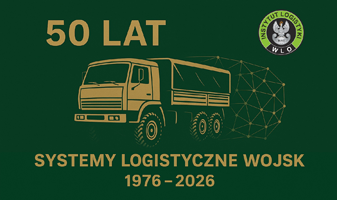ORIGINAL PAPER
LOGISTIC-COMBINATORIAL DUALISM OF SETTING THE TRAVELLING SALESMAN
1
Akademia Marynarki Wojennej
Publication date: 2015-07-10
SLW 2015;42(1):45-64
ABSTRACT
At the work described dual character of the vehicle routing stayed (TPS – Travelling Salesman Problem) which can simultaneously be considered as the utilitarian transport task according to logistic criteria and as a combinatorial many-sided problem of discreet optimization. In the operational research aspect the TSP task is included in problems NP-complete, which in general effective methods of solutions don’t exist for. On account of very wide range of logistic applications of the TSP task they made the presentation the most of popular methods of untying him. They paid special attention to the modern attempt based on methods of the artificial intelligence and ant algorithms. The classic TSP problem is a special case very much important in the contemporary logistics of the multidimensional problem route projecting among others onto total costs of transport and logistic activity.
REFERENCES (35)
1.
Aarts E., Lenstra J. (2003). Local search in combinatorial optimization. John Wiley & Sons.
2.
Applegate D.L., Bixby R.E., Chvátal V., Cook W.J. (2007). The Traveling Salesman Problem: A Computational Study. Lanchester Prize, Princeton University Press.
4.
Bozarth C., Handfield R.B., (2007). Wprowadzenie do zarządzania operacjami i łańcuchem dostaw. Gliwice: Helion S.A.
5.
Christopher M., (1992). Logistyka i zarządzanie łańcuchem podaży. Kraków: Wyd. PSB.
6.
Clerc M., (2000). Discrete Particle Swarm Optimization Illustrated by the Travelling Salesman Problem.
8.
Cook W.J. (2012). In Pursuit of the Traveling Salesman: Mathematics at the Limits of Computation. Princeton University Press.
9.
Cormen T.H., Leiserson Ch.E., Rivest R.L., Stein C. (2007). Wprowadzenie do algorytmów. Warszawa: WN-T.
11.
Deo N. (1980). Teoria grafów i jej zastosowanie w technice i informatyce. Warszawa: PWN.
12.
Do Tianrui R., Yong L. X. (2010). Computational Intelligence. World Scientific Publishing Company.
13.
Dorigo M., Maniezzo V., Colorni A. (1996). The Ant System: Optimization by a colony of cooperating agents, IEEE Transactions on Systems, Man, and Cybernetics – Part B, 26 (1).
15.
Duch W., Mandziuk J. (2011). Challenges for Computational Intelligence. Springer.
16.
Ficoń K. (2006). Badania operacyjne stosowane. Modele i aplikacje. Warszawa: BEL Studio.
17.
Ficoń K. (2013). Sztuczna inteligencja. Nie tylko dla humanistów. Warszawa: BEL Studio. Warszawa.
18.
Glover F. (1986). Future Paths for Integer Programming and Links to Artificial Intelligence, Computer and Operations Research, vol. 13, no. 5.
19.
Hall S.N. (2012). A Group Theoretic Tabu Search Approach to the Traveling Salesman Problem. Biblioscholar.
20.
Holland J.H. (1975). Adaptation in Natural and Artificial Systems. University of Michigan Press.
21.
Kosiński R.A. (2007). Sztuczne sieci neuronowe. Dynamika nieliniowa i chaos. Warszawa: WNT.
24.
Kulikowski J.J. (1986). Zarys teorii grafów. Zastosowania w technice. Warszawa: PWN.
25.
Kwaśnicka H. (1999). Obliczenia ewolucyjne w sztucznej inteligencji. Wrocław: Wyd. PW.
26.
Metropolis N. et al. (1953). Equation of State Calculations by Fast Computing Machines. The Journal of Chemical Physics 21 (6): 108
27.
Michalewicz Z. (1998). Algorytmy genetyczne + struktury danych = programy ewolucyjne. Warszawa: WNT.
28.
Nilsson C. (2003). Heuristics for the traveling salesman problem, Department of Computer Science, Linkoping University.
30.
Pszczołowski T. (1978). Mała encyklopedia prakseologii i teorii organizacji. Wrocław-Warszawa-Kraków-Gdańsk: Ossolineum.
31.
Radzikowski W., Sarjusz-Wolski Z. (1994). Metody optymalizacji decyzji logistycznych. Toruń: Wyd. UW.
32.
Ramani G. (2011). Travelling Salesman Problem (TSP) optimization through Genetic Algorithm: Improvised solution to VLSI Detailed Routing and National Tour Paperback – September 8.
We process personal data collected when visiting the website. The function of obtaining information about users and their behavior is carried out by voluntarily entered information in forms and saving cookies in end devices. Data, including cookies, are used to provide services, improve the user experience and to analyze the traffic in accordance with the Privacy policy. Data are also collected and processed by Google Analytics tool (more).
You can change cookies settings in your browser. Restricted use of cookies in the browser configuration may affect some functionalities of the website.
You can change cookies settings in your browser. Restricted use of cookies in the browser configuration may affect some functionalities of the website.


